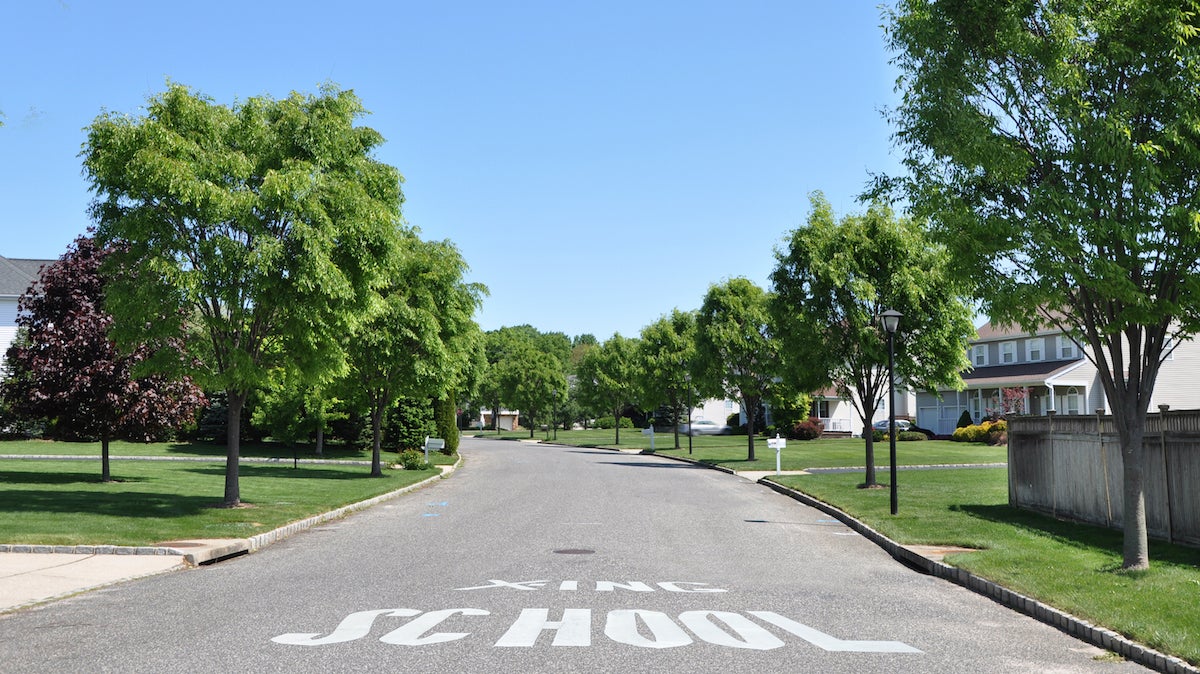The road to suburbia: From Northwest Philly to Abington
 Suburban street photo via ShutterStock " title="shutterstock_97056983" width="1" height="1"/>
Suburban street photo via ShutterStock " title="shutterstock_97056983" width="1" height="1"/>
Suburban street photo via ShutterStock
My parents moved to Germantown in the mid-80s to get out of a neighborhood that at the time was very segregated.
Raising their kids in a racially and economically diverse community was really important to them, so they bought a fixer-upper between the park and the police station. Growing up in Germantown, in the shadow of the crack epidemic, had its challenges. Muggings were a dime a dozen, rainbow colored baggies and vials littered the sidewalk on my walk to school, and more than once my backyard became an escape route for someone running from the police.
I attended Germantown Friends School for eight years and realized that most of the kids who were bussed in from the suburbs were afraid of my neighborhood. They ventured out into the streets only to do their mandated numbers of community service.
It hit a nerve the same way it does when someone picks on your kid brother — you’re allowed to do that, but no one else is. For every bad thing that may have been happening, there was good too. Through all that, there were lessons too: making sandwiches for the many homeless people who knocked on our door, learning how to carry myself so I wouldn’t look vulnerable, navigating SEPTA, giving all my allowance to buskers outside city hall.
The city shaped me.
When my husband and I met, it was clear that we were both city people. We shared the same taste one acquires when they grow up in the city — the restlessness, the need for movement, the constant lights and sounds, sirens in lieu of lullabies.
All grown up, that restless city streak, that insatiable travel bug, finally got its fix. When our twins were four months old we moved 5,000 miles away to live in Brazil, my husband’s homeland. When we moved back, our kids just over 19 months old, and we settled down in Mt. Airy.
I had missed Mt. Airy, and dreamed of raising our kids there.
We began looking for a house to buy, and the Philadelphia School District slipped further and further into a financial abyss, deeply neglected in a myriad of ways. We had to face facts. The two schools we had been looking at for the boys, offered little in the way of real estate that met our criteria and price range.
Looking a bit a further into Germantown, we were faced with either paying two times a private school tuition we couldn’t afford, or throwing ourselves into charter school lotteries, which I have mixed feelings about on most days.
We widened our lens and began to look outside the city. I never imagined myself living in the suburbs, and the first few times we looked at houses in Delaware and Montgomery counties, I couldn’t quite get myself on board.
“It’s too quiet,” I would declare as we’d pull into the driveway of a colonial.
On the way to showings, sometimes I would have made up my mind before we even opened the door. Too much American cheese on Wonder Bread with mayonnaise. Our kids will feel different, our kids will stick out.
“Is that a bad thing?” My husband would muse, and off I would go about the importance of surrounding them with as many cultures and types of family structure as we could.
It’s not the city, I said, it’s not Mt. Airy. Time passed, and ultimately our rental situation soured. Our block was not friendly, not even safe.
When we went to look at houses in Abington, I tried to leave my skepticism behind. The schools are good, the crime rates low, there are a lot of kid-centric activities, maybe it could work.
Then we saw The House: this little house, with a huge backyard, a driveway, an enclosed front porch, surrounded on all sides by huge trees. It was my dream house, and a house I could never afford within city limits. At the corner, kids of every color waited for the bus and played together. It was, dare I say, more diverse than any neighborhood I’d lived in in Philly.
Every street was adorned with Watch Children signs, and kids even rode their bikes down the road in the afternoon sun. As we trudged through the long process of making it ours, there was a certain sadness and a marked eagerness to move on to the next chapter of our lives.
The street smarts, the awareness of others — of true racial, socio-economic and cultural diversity — these are things that being in the city gave me, and things I want for my children too, but are they really exclusive to the city?
I don’t want my kids to be like my old schoolmates who were afraid to venture out into the city, but is that really a necessity of living in suburbia? A big backyard that twinkles with fireflies on a summer evening, cottontails hopping across the street every morning, trees that beg for tree houses, and top-rated public schools within walking distance? Those are things I didn’t have that I want for my kids. It’s been six months since we moved into our new house, and while it hasn’t been without challenges, it has been pretty dreamy.
There are moments, good and bad, that I find myself wide-eyed at suburban happenings, like the robotic arms on the trash trucks, or the ease of township bureaucracy, or that all the public schools still have the kids recite the Pledge of Allegiance.
In those moments I think to myself, I don’t think we’re in Mt. Airy anymore Toto, but maybe that’s OK.
WHYY is your source for fact-based, in-depth journalism and information. As a nonprofit organization, we rely on financial support from readers like you. Please give today.

